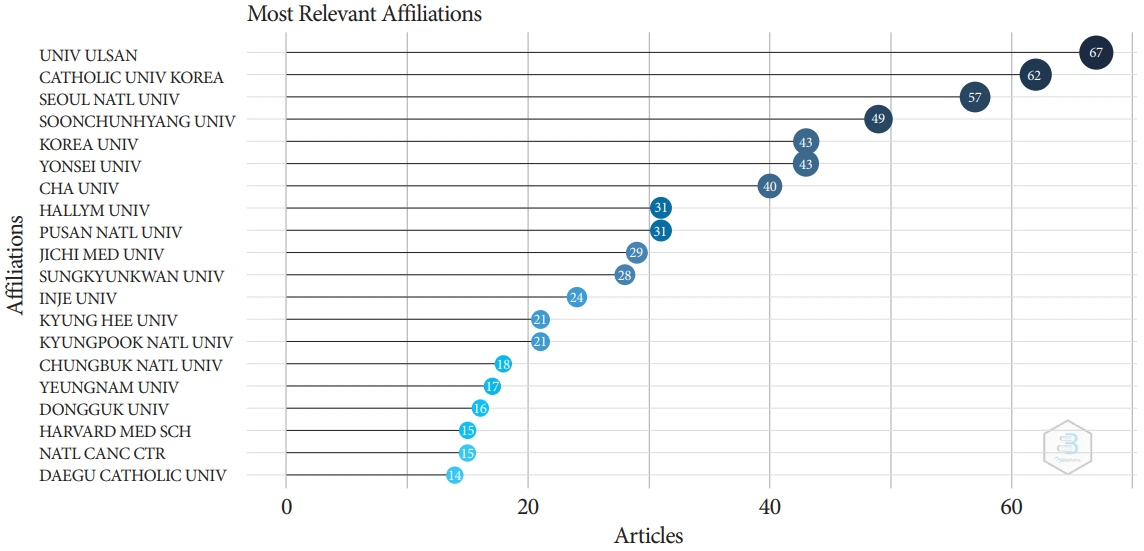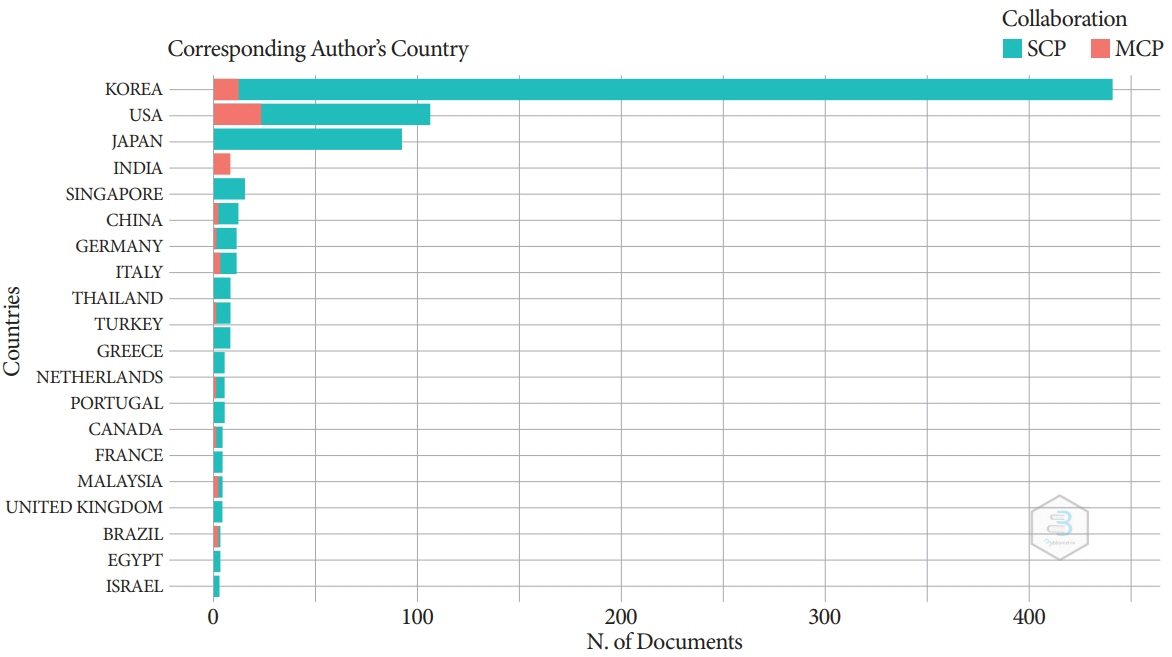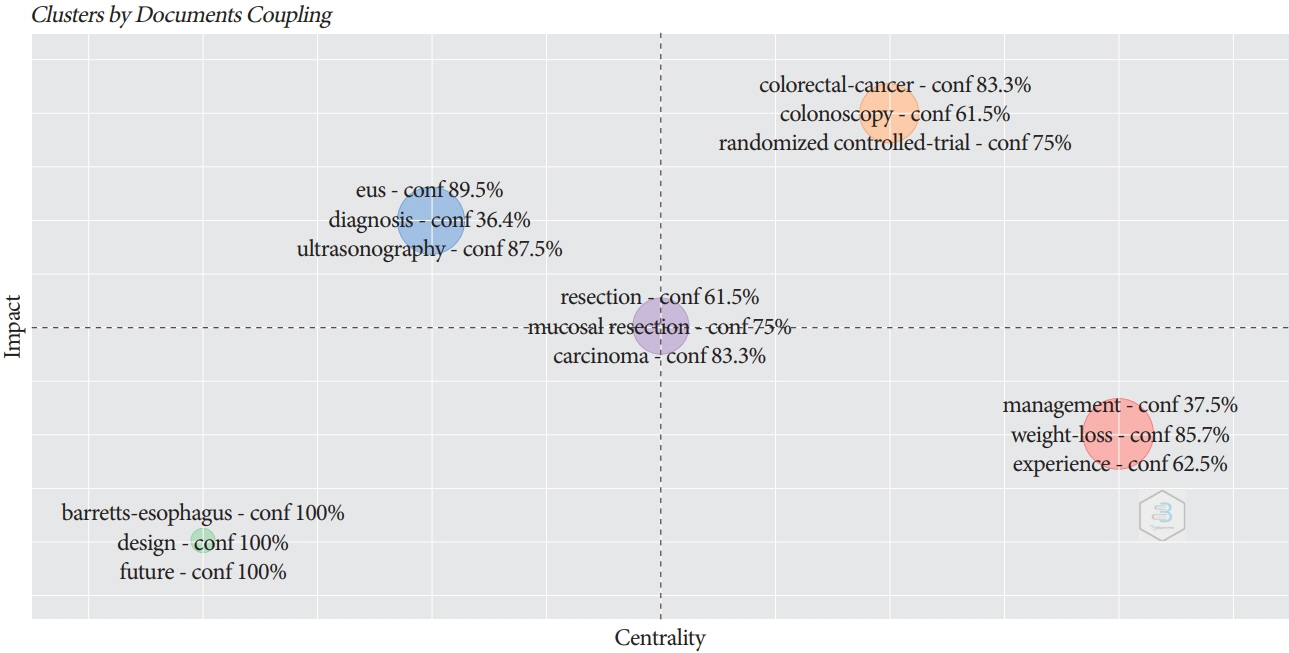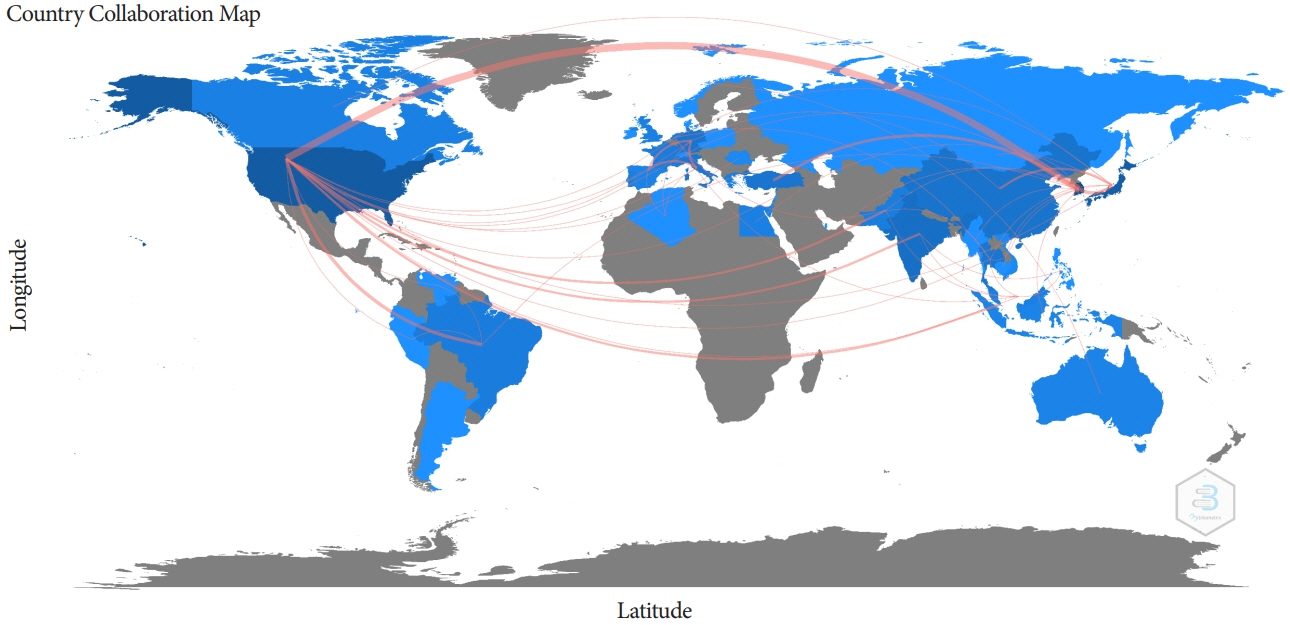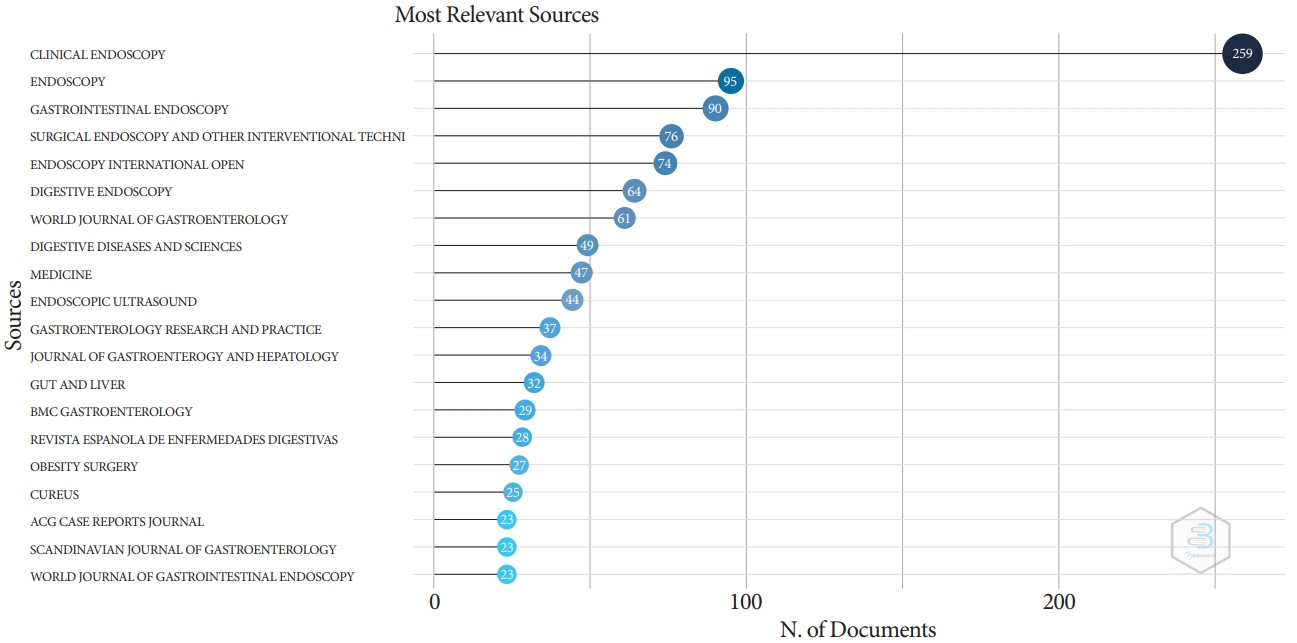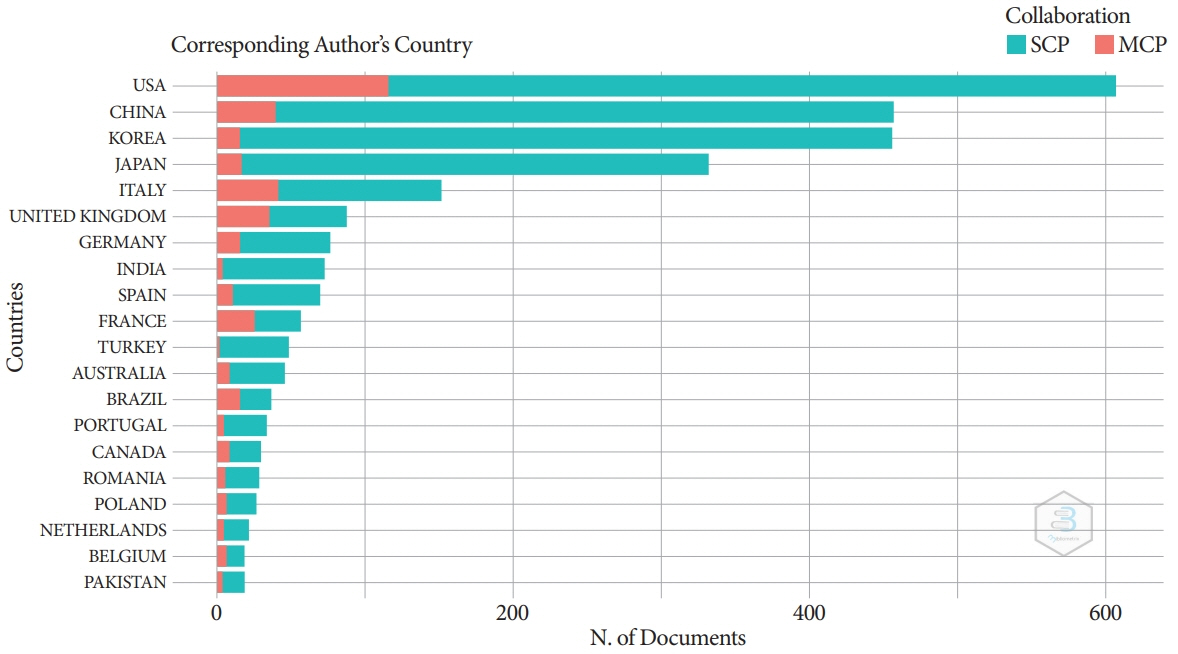Clin Endosc.
2021 Sep;54(5):641-650. 10.5946/ce.2021.207.
Document Network and Conceptual and Social Structures of Clinical Endoscopy from 2015 to July 2021 Based on the Web of Science Core Collection: A Bibliometric Study
- Affiliations
-
- 1Department of Parasitology and Institute of Medical Education, College of Medicine, Hallym University, Chuncheon, Korea
- KMID: 2520546
- DOI: http://doi.org/10.5946/ce.2021.207
Abstract
- Background/Aims
The present study investigated the relevance and network of institutions, keywords, and authors’ countries of the articles in Clinical Endoscopy published from 2015 to May 2021 based on the Web of Science Core Collection.
Methods
The Web of Science Core Collection was searched with the term Clinical Endoscopy as the publication title on July 12, 2021. All 776 citations published from 2015 to May 2021 and 2,964 articles citing those 776 articles were analyzed using Biblioshiny.
Results
The corresponding authors were from 73 countries. Document coupling showed that the colorectal cancer-colonoscopyrandomized controlled trial cluster had the most significant impact and highest centrality. There were 442 articles with corresponding authors from Korea (57.0%). The number of collaborative works by Korean authors with the authors of other countries was 33 (7.5%). The articles were cited 2,964 times by corresponding authors from 37 countries.
Conclusions
The above results show that Clinical Endoscopy has published several studies on gastrointestinal endoscopy. A large proportion of citations (84.7 %) were from outside Korea, indicating that the journal content is useful for global physicians. Collaborative work between authors from Korea and other countries should be encouraged to promote the journal.
Figure
Cited by 1 articles
Reference
-
1. Khan AS, Rehman SU, Ahmad S, AlMaimouni YK, Alzamil MAS, Dummer PMH. Five decades of the International Endodontic Journal: bibliometric overview 1967-2020. Int Endod J. 2021; 54:1819–1839.2. Alhajj MN, Al-Sanabani FA, Alkheraif AA, Simran A, Alqerban A, Samran A. Bibliometric analysis and evaluation of the Journal of Prosthetic Dentistry from 1970 to 2019. J Prosthet Dent. 2021; S0022-3913(21)00279-1.
Article3. Kim KW, Jeong GH. Network of institutions, source journals, and keywords on COVID-19 by Korean authors based on the Web of Science Core Collection in January 2021. Sci Ed. 2021; 8:47–56.
Article4. Rusydiana AS. Bibliometric analysis of journals, authors, and topics related to COVID-19 and Islamic finance listed in the Dimensions database by Biblioshiny. Sci Ed. 2021; 8:72–78.
Article5. Oh J, Kim A. A bibliometric analysis of COVID-19 research published in nursing journals. Sci Ed. 2020; 7:118–124.
Article6. Kim Y, Yoon DY, Kim JE, Lee JH, Song HK, Bae JS. Historical diagnostic and therapeutic changes of ischemic stroke based on the highly cited articles. Sci Ed. 2020; 7:156–162.
Article7. Choi HW, Choi YJ, Kim S. Network analysis of scientific collaboration in North Korea. Sci Ed. 2019; 6:25–34.
Article8. Kim K, Chung Y. Bibliographic and content analysis of physics papers from North Korea indexed in the Scopus from 2005 to 2018. Sci Ed. 2019; 6:35–40.
Article9. Vandenbroucke JP, von Elm E, Altman DG, et al. Strengthening the Reporting of Observational Studies in Epidemiology (STROBE): explanation and elaboration. Ann Intern Med. 2007; 147:W163–W194.
Article10. Aria M, Cuccurullo C. Bibliometrix: An R-tool for comprehensive science mapping analysis. J Informetr. 2017; 11:959–975.11. Clarivate Analytics. KeyWord Plus generation, creation, and changes [Internet]. London: Clarivate Analytics;c2018 [cited 2021 July 10]. Available from: https://support.clarivate.com/ScientificandAcademicResearch/s/article/KeyWords-Plus-generation-creation-and-changes?language=en_US.12. Wikipedia. Multiple correspondence analysis [Internet]. San Francisco, CA: Wikimedia Foundation;c2020 [cited 2021 July 10]. Available from: https://en.wikipedia.org/wiki/Multiple_correspondence_analysis.13. Jeong GH, Huh S. Increase in frequency of citation by SCIE journals of non-Medline journals after listing in an open access full-text database. Sci Ed. 2014; 1:24–26.
Article14. Choi YJ, Choi HW, Kim S. Preprint acceptance policies of Asian academic society journals in 2020. Sci Ed. 2021; 8:10–17.
Article15. Yi HJ, Huh S. Korean editors’ and researchers’ experiences with preprints and attitudes towards preprint policies. Sci Ed. 2021; 8:4–9.
Article16. Vuong QH. The rise of preprints and their value in social sciences and humanities. Sci Ed. 2020; 7:70–72.
Article17. Kim J. An analysis of data paper templates and guidelines: types of contextual information described by data journals. Sci Ed. 2020; 7:16–23.
Article18. Choi YJ, Choi HW, Kim S. Compliance of “Principles of transparency and best practice in scholarly publishing” in Korean academic society-published journals listed in Journal Citation Reports. Sci Ed. 2020; 7:24–33.
Article19. Choi HW, Choi YJ, Kim S. Compliance of “Principles of transparency and best practice in scholarly publishing” in academic society published journals. Sci Ed. 2019; 6:112–121.
Article
- Full Text Links
- Actions
-
Cited
- CITED
-
- Close
- Share
- Similar articles
-
- Journal metrics, document network, and conceptual and social structures of the Korean Journal of Anesthesiology from 2017 to July 2022: a bibliometric study
- Analyzing and Visualizing Knowledge Structures of Health Informatics from 1974 to 2018: A Bibliometric and Social Network Analysis
- Position of Ultrasonography in the scholarly journal network based on bibliometrics and developmental strategies for it to become a top-tier journal
- Fifty Years of Cervical Myelopathy Research: Results from a Bibliometric Analysis
- Publication trends of somatic mutation and recombination tests research: a bibliometric analysis (1984‒2020)

